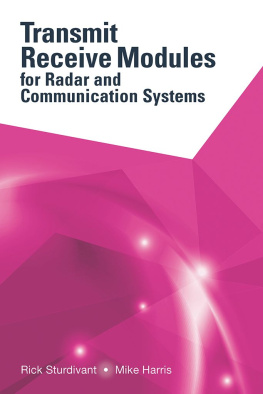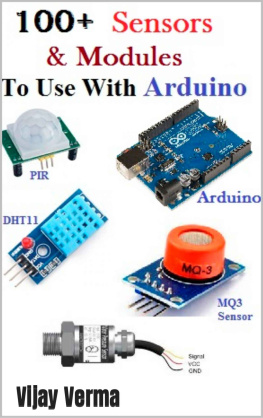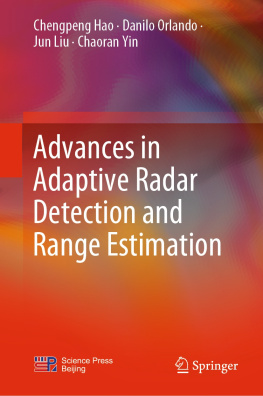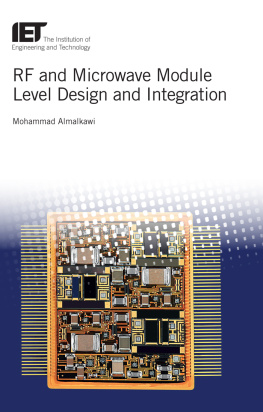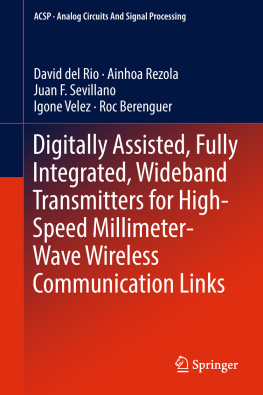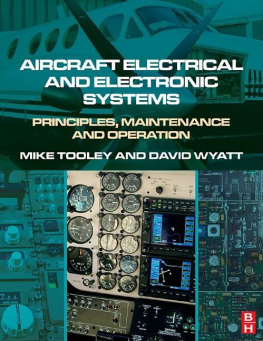Transmit Receive Modules for Radar and Communication Systems
For a complete listing of titles in the
Artech House Radar Series,
turn to the back of this book.
Transmit Receive Modules for Radar and Communication Systems
Rick Sturdivant
Mike Harris

Library of Congress Cataloging-in-Publication Data
A catalog record for this book is available from the U.S. Library of Congress.
British Library Cataloguing in Publication Data
A catalogue record for this book is available from the British Library.
Cover design by John Gomes
ISBN 13: 978-1-60807-979-7
2016 ARTECH HOUSE
685 Canton Street
Norwood, MA 02062
All rights reserved. Printed and bound in the United States of America. No part of this book may be reproduced or utilized in any form or by any means, electronic or mechanical, including photocopying, recording, or by any information storage and retrieval system, without permission in writing from the publisher.
All terms mentioned in this book that are known to be trademarks or service marks have been appropriately capitalized. Artech House cannot attest to the accuracy of this information. Use of a term in this book should not be regarded as affecting the validity of any trademark or service mark.
This book is dedicated to my wife Linda, and our daughters, Michelle and Amanda
Mike Harris
This book is dedicated to my wife Jonie and our children, Lauren and Jeremy
Rick Sturdivant
Contents
Preface
Transmit/receive (T/R) modules are the key components in active electronically scanned arrays (AESAs) for radar and communications applications. T/R modules are circuits that provide system advantages in both transmit and receive by reducing front end losses. The system noise figure is set and the RF power is generated at the aperture front-end using T/R modules. This results in increased system sensitivity over passive arrays. Other advantages include weight reduction and prime power reduction for equivalent system sensitivity. The single-point failure of the radar or communication system is eliminated by the redundancy that an AESA provides.
Rapid advances in AESAs were made as a result of the maturation of compound semiconductors that provide better performance at high frequencies than silicon. Major defense acquisition programs pioneered the development of AESAs even though risks were higher than using a traditional tube-based approach.
Significant research and development results have been published over the past 25 to 30 years on power amplifiers, low noise amplifiers, and other RF components that make up the RF chipset in T/R modules. However, no comprehensive treatment of the subject of T/R modules has been published until now.
In this book, we have condensed 30 years of applied research and development of RF front-end technologies. We were motivated, in part, to write it as a result of a professional education course that we taught on the subject of T/R modules. Comprehensive treatment of T/R modules is presented in this book through topics that include: an introduction to phased arrays in radar and communication systems, T/R modules and module components, monolithic microwave integrated circuits (MMICs), T/R module packaging, RF interconnect materials, thermal management for T/R modules, MMIC and T/R module manufacturing, testing, module cost, and next-generation T/R modules.
presents the system level knowledge required for T/R modules. It explains the methods used to calculate signal to noise ratio for radar point targets, weather radar, and communication systems. This allows for system level trade off of transmitted power, receive noise figure and other items that determine T/R module specifications.
presents the components that make up T/R modules. Every element in the RF chain within the T/R module is discussed in detail and its key performance characteristics enumerated. Each RF component is covered in a logical progression through the transmit chain and the receive chain. A gain/loss budget analysis is presented and practical exercises are included to enrich the learning experience and to show the interdependence of the RF components and the trade-offs that must be considered.
focuses on MMICs, which are the most important and most expensive components making up T/R modules. Starting materials for the MMICs are critical to obtain the desired RF performance so extensive details of how these materials are grown are presented. Bandgap engineering that overcomes conflicting electronic properties is fully explained. Gallium nitride (GaN), currently the most promising material technology for power amplifiers, is discussed in depth.
show the electronic packaging issues and materials issues. The knowledge about packaging required for successful realization of T/R modules is presented. We also show how proper choice of materials is required and how to apply a process flow for it. This will allow designers and managers to make optimized choices about interconnect, transitions, materials, and other packaging concerns.
presents heat flow. We present the know-how required to successfully calculate heat dissipation, junction temperate, and mean time to failure for electronic components in T/R modules.
reveals how MMIC and T/R module manufacturing is an enormous undertaking that requires a long-term vison and commitment. Both are driven by the desire for high-yield, few defects per million opportunities, and Six Sigma methodologies. Manufacturing processes and process control monitoring are addressed in detail.
presents the necessary information on manufacturing T/R modules and its components. MMICs are made in a batch process and many possible good die are made at the same time. Modules are assembled with automated work cells and rates may be on the order of 5,000 per month or more. Automated in-process and final testing are essential and are discussed in this book.
focuses on cost. Once T/R module performance is verified and module reliability is proven, the focus quickly turns to cost reduction. This book addresses the complex topic of T/R module cost and breaks down the cost factors and discusses how module cost can be reduced.
Finally, analyzes next-generation T/R modules and covers a wide range of technologies that will impact future T/R modules and AESAs in general. Most of the current T/R modules are hermetic metal modules with ceramic substrates. This will change in the near future due to several contributing factors that we discuss. Widespread availability of silicon germanium (SiGe) and silicon-complementary metal-oxide semiconductor (Si-CMOS) integrated circuit processes that support operation into millimeter-wave frequencies offer the potential to produce T/R channels at a cost that is 100 to 1,000 times lower than is possible using traditional methods. Cost reduction will come with performance tradeoffs, to be sure. However, this does not negate the impact that SiGe and Si-CMOS IC processes will have on near-term and future T/R modules and AESAs.
In summary, this book details with all aspects of T/R modules for communications and defense radar applications. It contains enough information for a one-semester senior or graduate-level course. This book is ideally suited for program managers that must make key decisions regarding technology for their radar products. It can be used by practicing engineers and technology professionals working in phased array technologies. This text is particularly well suited as a reference for a 3-day to 5-day professional education course.
Next page
